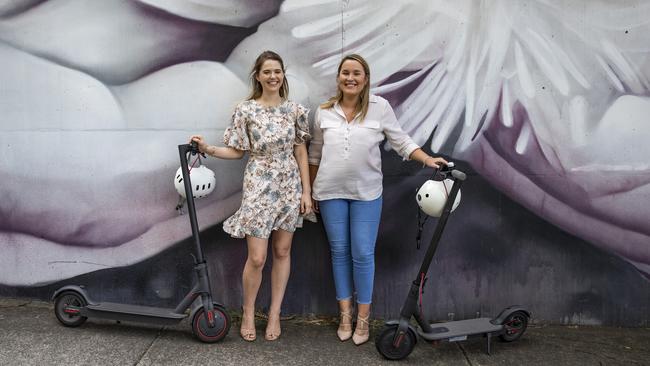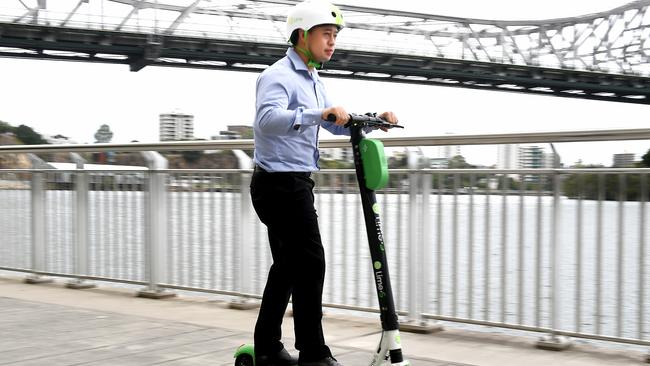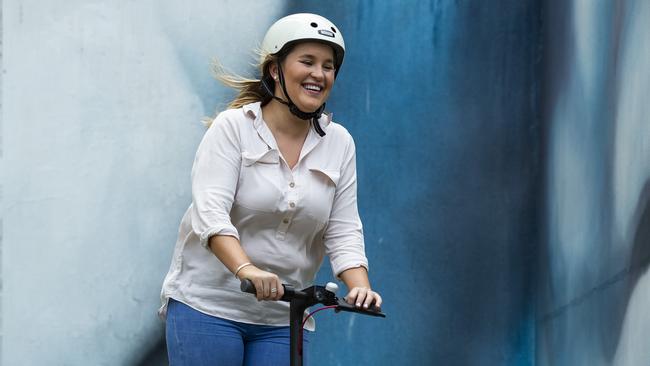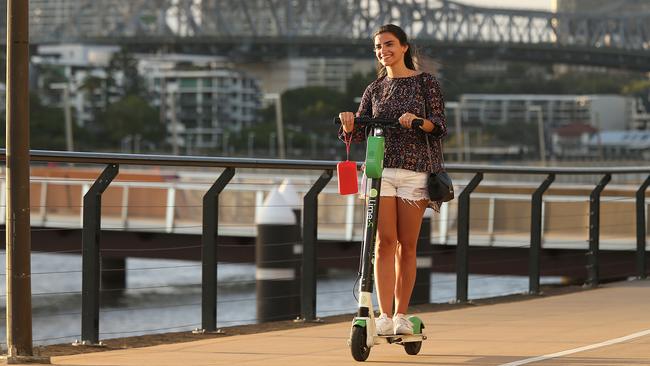Brisbane e-scooter obsession: the dark side and the case for Australia’s micro-mobility craze
They have been described as the ultimate commuting solution, the ‘bin chickens of Brisbane’ and a pedestrian nightmare. What’s the real story behind Brisbane’s e-scooter craze?
QWeekend
Don't miss out on the headlines from QWeekend. Followed categories will be added to My News.
WE WEAR watermelon-themed helmets.
We’re threatened by potholes.
We reach top speeds of 25 kilometres an hour.
And we look out for distracted pedestrians who won’t look up from smartphones.
We are e-scooter riders, micromotorists, the geekiest motorcycle club in Australia, and our numbers are growing.
Mel Buttle’s brutal take on Brisbane suburbs: THE FULL LIST
Hannah’s untold story and the heart-wrenching goodbye
But, unlike other tech trends, this geeky gang formed in Brisbane, where its biggest base still resides.
You’ll find us zipping beneath the Story Bridge, cruising through South Bank, leaning around the curves of Riverwalk, or scouting nervously for fallen branches in the City Botanic Gardens.

Our favourite mode of transport has split academic, medical and public opinion, though.
Advocates will tell you micromobility is a building block in a future urban utopia. It will take cars off roads, cut carbon footprints, encourage cycle grids, tackle inequalities within private and public transport, and ensure we feel wind in our hair on otherwise dreary commutes.
One study described scooting as “a combination of the most desired attributes of travel: freedom and control of driving, pleasantness of walking, excitement of cycling, and convenience of skateboarding.”
But there are painful downsides and lingering questions about Australia’s growing e-scooter army too.
Injuries can be common among unprotected riders; many caused by risky behaviour, some by inexperience, some by faults with the technology itself. Scary photos of riders with missing teeth and fractured bones are too common for comfort.
Then there are questions about the safety of pedestrians on crowded footpaths, liability in the case of crashes, the economics of shared scooter schemes, and whether the new mode of transport discourages people from the most basic but healthy form of transportation; the one involving their feet.
Experts say evidence for and against e-scooters is still emerging, and Brisbane is in a rare position to predict the future of this disruptive mode of travel.
Queensland became an unlikely micromobility testbed in 2018.

On the morning of Friday, November 16, a cluster of green, two-wheeled vehicles appeared beside footpaths in the city’s CBD and South Bank, as if they’d hatched overnight.
Their sudden arrival actually followed negotiations between the Department of Main Roads and Transport, Brisbane City Council, and a San Francisco tech unicorn named Lime that was keen to introduce dockless e-scooters to an untapped market.
Each electric scooter had a fresh helmet hanging from its handlebars (in what is now more of a rarity), a top speed of 27km/h, and an enticement to download and an app and scoot around the city.
Their appearance heralded the start of a year-long trial for e-scooters in Brisbane that’s now been extended, making the vehicles legal to ride in Australia and dividing opinion.
Those who loved Lime’s scooters told their friends, colleagues, and mates interstate. They zipped around footpaths like never before, adding to what is now a tally of more than two million rides.
Others sneered at “footpath rubbish” and many still do; one resident recently told me he considered Lime scooters “the electronic bin chickens of Brisbane”.
But their rising popularity is undeniable.
In addition to a sea of 1000 green and orange rentable scooters from Lime and Singaporean brand Neuron, a new wave of privately owned electric scooters is hitting paths around the city and the suburbs.
More than 155,000 scooters had been purchased privately in Australia by November last year, according to Lime, and Scooter Hut Brisbane sales assistant Keedan Mitchell says their numbers have skyrocketed over the last six months.
“Every five minutes someone cruises past the store on their own electric scooter or a rideshare,” he says. “It’s just blown up.”
Mitchell says e-scooter buyers are typically aged between 20 and 40, more are men, and most are looking for a fun way to get to university or work that doesn’t involve paying strangers for a ride or sky-high parking fees.
“People come in and say they’re Ubering to and from work every day, which is at least $20 a day, so this is cheaper,” he says. “Rather than getting a cheap car, which requires fuel and rego, this is just a single purchase and you only have to charge it.”
Veteran riders who have become hooked on renting e-scooters are also big buyers, Segway Ninebot Australia marketing manager Tialyn Loechel says from its newly established Milton store.
“People get a bit frustrated once they’ve been using the rideshare scooters for a while because it can become really expensive,” he says. “Once you buy them, they pay themselves off within a year or sooner.”

E-scooters are also getting significantly more advanced in Australia.
The Ninebot Kickscooter Max features pneumatic tyres that offer a smooth ride without punctures, for example. The Mercane WideWheel Pro features two motors to avoid the embarrassment of pushing a scooter up a hill.
And a Melbourne start-up plans to take advantage of Australia’s growing interest in e-scooters, currently accepting preorders for a vehicle with big wheels, traction control, customised lighting, and a range of up to 40km.
Raine Scooters co-founder Michelle Mannering says the team raised more than $600,000 for the new scooter on Kickstarter, and she predicts many more Aussies will buy a ride this year.
“A lot of people have been forced to buy e-scooters from places like eBay and Alibaba but now we’re seeing more and more retail stores get them,” she says.
“We want to get more out there. We want to see people to get up in the morning and be like, ‘yeah, I’m going to work today on my scooter, it’s gonna be fun!’”
Brisbane real estate marketer, Nina Clarke, is always counting down to her twice-daily scoot.
The exuberant rider says she is still just as keen to get to work in the morning as she is to leave in the afternoon simply because she’ll be soaring through sunshine in both directions.
“I’ve been riding for four months and the excitement has not worn off at all,” she says.
The Ray White rep says she fell in love with e-scooter life after trying Lime scooters on a visit from Sydney. When she moved back to Brisbane, into the inner city suburb of Newstead, it made more sense to buy her own scooter than invest in a car.
Scooting to work did make her self-conscious though, being that she was dressed for the boardroom with a black stack hat on top.
“You have to get past the initial embarrassment,” she laughs.
“I found using Lime scooters was less embarrassing than having bought my own, at first. I always saw people I knew and they’d laugh at me because I had my dorky helmet on and my heels but I’ve gotten over that. Now that it’s getting more popular I’m not so embarrassed by my weird mode of transport.”

Clarke says she regularly scoots past “at least another 10” private scooter riders en route to the city, many with the same Xiaomi model she rides.
But the informal gang of scooting commuters faces a chilly reception from some parts of the community.
“The cyclists, I don’t know if they like scooters. Some of them come up close behind and act like they’re annoyed about us. Often I overtake cyclists,” she says.
“But pedestrians will often look at me and smile because they think it’s so weird and fun. I don’t get many rude people. I think they like us better than cyclists. I don’t know why.”
And aside from “getting out into the sun,” Clarke says she’s saved money on two wheels. Her scooter cost her $500 and, while she’s had fix a tyre puncture, other costs have been minimal.
“I did the figures and, considering the cost of riding the bus, I would have paid off my scooter within a couple of months,” she says.
“If you’re not required to have a car, or if you and your partner have two cars, you could save so much money by getting rid of one your cars for a scooter. You don’t pay rego, you don’t pay insurance, if something happens to your scooter, you only lose $500.”
Other riders are joining Brisbane’s scooting gang for different reasons.
Hydrologist Peter Khor says he bought an e-scooter after walking to work for 10 years. “Even saving five minutes each day adds up,” he says.
Another Brisbane rider, Tracey Williamson, who scoots to her job wearing a striking Nutcase Watermelon helmet, says she bought herself an e-scooter as a Christmas gift after months of renting Lime vehicles.
For me, buying an e-scooter was part lucky break, part childhood throwback.
At the age of seven, I spent a lot of afternoons pushing a tatty red scooter, saved from the tip by my Dad, up and down the footpath outside our home.

So when my car broke down last year, I began chasing Lime scooters and nostalgia through the neighbourhood. E-scooters were often scarce, in high demand, and sometimes broken, but they were so much fun to ride.
From a tentative start, I became skilled at avoiding potholes, racing angry puppies, ignoring cranky joggers, and plotted an efficient route to my work, connecting two scenic and smooth bike paths.
My commute became fun. It no longer relied on a good song playing on the radio; I was outdoors, shedding stress, seeing more of my neighbourhood, becoming a nerdy adventurer all over again.
By the time my car was fixed, my mind was fixed on a new mode of transport.
Now when the weather allows, I fit my Speedracer-style helmet, unplug my ride, test the bell, and hit the footpaths.
Despite their growing popularity, there is a dark side to e-scooters, and it’s well documented.
At least 29 people have died in e-scooter crashes worldwide since 2018.
That tragic statistic includes a 50-year-old man who suffered critical injuries after riding down stairs near the Wheel of Brisbane at South Bank.
E-scooter injuries are also alarmingly common.
A software malfunction in Lime scooters early last year reportedly caused the wheels of some vehicles to lock up. At least one rider reported serious facial injuries after flying over the handlebars before a fix was issued.
More than 130 Lime scooter riders also presented to five central Brisbane hospitals for treatment after accidents in the first two months of 2019 – an average of two per day, according to a study by the Australian Injury Prevention Network and Royal Australasian College of Surgeons.
Abrasions were the most common scooter injury, followed by upper limb fractures, sprained limbs, minor head injuries, and lower limb fractures.
Disturbingly, hospital staff also treated three major head injuries.
But the study noted there wasn’t enough information about the cause of the accidents, and whether speed, alcohol, drug consumption or the absence of helmets played a role.

“We do not know whether they are associated with an increase in injuries per person or per journey compared with other transport options,” it said.
Evidence from scooter accidents in New Zealand and the United States could be more telling.
A study of e-scooter injuries treated in Auckland hospitals found men were most likely to be injured, alcohol played a role in more than a quarter of all accidents, and five per cent of patients reported a head injury.
Author and emergency medicine specialist Dr James Le Fevre said the findings proved something most probably expected: “a motorised narrow platform on wheels, no helmet and alcohol consumption is a dangerous combination”.
Research from the University of California also identified men aged 20 to 40, under the influence of alcohol, drugs or both, and not wearing a helmet were at the highest risk of e-scooter injuries.
And Brisbane has not been immune to risky behaviour on wheels.
The Queensland Police Service issued 1,086 infringement notices for offences on “personal mobility devices” including e-scooters last year.
These fines, of up to $174, punished riders for drinking and riding, speeding, being distracted by a mobile phone, and even riding on banned roads.
“The majority of these infringement notices were issued for failure to wear a bicycle helmet without exemption,” a QPS spokeswoman told Qweekend.
QUT professor Dr Narelle Haworth, from the Centre for Accident Research and Road Safety-Queensland, also identified a lot of risky behaviour among Brisbane scooter riders in an observational study captured over four days.
Almost half of all electric scooters observed in six locations were being ridden illegally; most without helmets or without helmets worn properly, some too young, and some riding with a passenger.
But, in a glimmer of hope, she also found private e-scooter riders were more safety-conscious: 95 per cent wore their helmets correctly compared to just 60 per cent of renters.

It could follow, Dr Haworth says, that the growing number of committed e-scooter users are safer riders.
“Any move towards more private use would be reflected in an overall improvement in safety,” she says. “That was probably one of the strongest findings in our study.”
But not enough is known about the habits of private scooter riders, she says, as most studies are based on figures from shared schemes.
As the two kinds of riders “seem to be very different,” she says, academics and medical professionals may not yet have uncovered the full picture of e-scooter use worldwide.
New research is emerging to rebuild their shambolic reputation, however.
A study from the International Transport Forum, part of the OECD, shows there are significant upsides to getting commuters out of cars and on to two wheels.
Not only could the growing use of e-scooters cut pollution but it could “improve traffic safety by reducing the number of car and motorcycle trips in a city,” it found.
“It can increase the catchment area of public transport by allowing wider access to stations. It can also offer a convenient door-to-door transport solution.”
Trips by cars and motorcycles were still “more likely to result in the death of a road user,” including pedestrians, the study said, and noted the “risk of an emergency department visit” for scooter riders was similar to that of cyclists.
It listed one catch, though: e-scooters’ only have a positive effect on safety if they convert drivers to two-wheeled travel, not pedestrians.
But Lime Asia Pacific government head Mitchell Price says Brisbane’s gamble on legalising e-scooters is already reducing the number of cars on roads and, despite injury reports, is ultimately benefiting the city.
“We’re moving more people out of cars and on to sustainable transport,” he says. “We’re starting to see people use this as part of their everyday commute. And Brisbane is one of the only cities in Australia where I don’t use Uber to go to and from meetings.”

Price admits regulating the use of e-scooters has been challenging for operators and regulators alike, and says the company is open to discussing changes to improve safety.
Lower speed limits could be introduced in future, he says, as well as “performance-based mechanisms where operators are rewarded or penalised” for their safety record. The question of whether scooter riders should be allowed in bike lanes on roads should be up for debate.
“There isn’t always enough room on footpaths, with street furniture and distracted pedestrians; you know, zombies walking around, looking at their phones,” he says. “Not all scooter users are doing the wrong thing and the majority would want a separate path.”
Some, including former lord mayoral hopeful Patrick Condren, have suggested scooters be allowed on a “dedicated, separated bike grid in the CBD”.
The proposal mirrors a recommendation in the OECD report, which calls for a “protected and connected network for micromobility”.
Challenges for Australia’s e-scooter industry include more than just safety.
Other cities and states are slowly following Brisbane’s lead to test the technology, including Adelaide, Canberra, Darwin, and Bunbury in Western Australia.
But state-based working groups and councils in New South Wales and Victoria have yet to formalise e-scooter trials despite years of discussions; delays Price says are holding Australia back and unfairly punishing operators.
“We can’t keep hanging around for governments to run a trial.
“We’ve had up to 30 staff members lose their jobs here in Australia because governments simply can’t give me a timeline on when we might see a new trial launching,” he says.
“It’s frustrating when you can see the scheme working so well in places like Brisbane and Adelaide, and countries like New Zealand, America, France, Germany and the UK.”
Ultimately, researchers predict e-scooters will become part of our transport future.
SAE International, a professional association for engineers, found e-scooters would continue to challenge regulators, would keep evolving, but would not disappear like a Millennial whim.
“The initial phases of curiosity and hype triggered by the sudden emergence of microvehicles has come and gone,” the organisation reported. “Yet the demand for micromobility does not appear to be winding down anytime soon.
“We speculate that micromobility is only at its beginning of the exponential innovation and growth curve.”
Two-wheeled speedsters in watermelon helmets could be here to stay.


